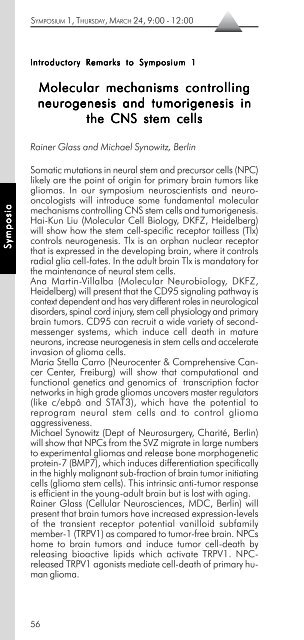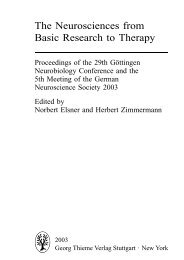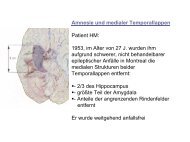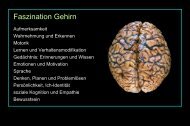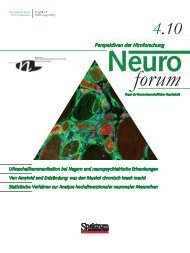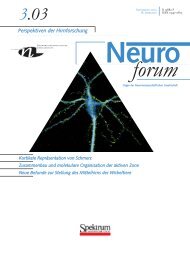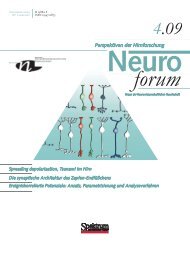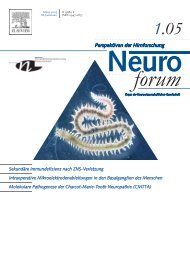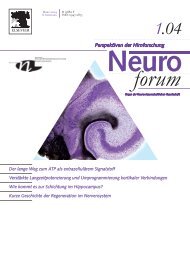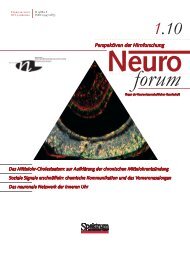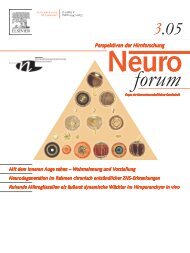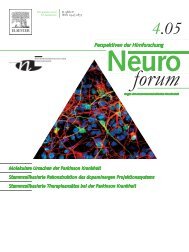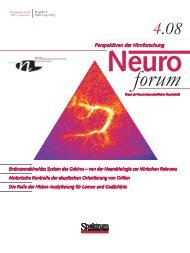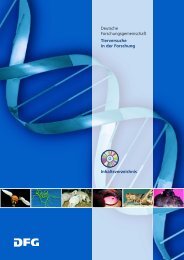- Page 1:
Ninth Göttingen Meeting of the Ger
- Page 4 and 5:
Instruments that are music to your
- Page 6 and 7:
WELCOME ADDRESS 4 Welcome elcome Ad
- Page 8 and 9: Gatan Digital Imaging for Electron
- Page 10 and 11: ACKNOWLEDGEMENT 8 Acknowledgement A
- Page 12 and 13: EXHIBITORS (A - C) 10 Exhibitors Ex
- Page 14 and 15: EXHIBITORS (D - I) Data Data Scienc
- Page 16 and 17: EXHIBITORS (I - M) Intelligent Inte
- Page 18 and 19: EXHIBITORS (M - P) MoBitec MoBitec
- Page 20 and 21: EXHIBITORS (P - T) PHYWE PHYWE Syst
- Page 22 and 23: EXHIBITION FLOOR PLAN 20 Exhibition
- Page 24 and 25: LIST OF ADVERTISERS 22 List List of
- Page 26 and 27: AWARDS TILL TILL Photonics Photonic
- Page 28: YOUNG INVESTIGATOR STIPENDS 26 Youn
- Page 31 and 32: No limits to behavioral testing!
- Page 33 and 34: Map Map of of Göttingen Göttingen
- Page 35 and 36: July 14-18, 2012 Barcelona | Spain
- Page 37 and 38: 220 V - 50 Hz AC. Electricity Elect
- Page 39 and 40: SCIENTIFIC PROGRAM (WEDNESDAY & THU
- Page 41 and 42: SCIENTIFIC PROGRAM (THURSDAY AND FR
- Page 43 and 44: Japanese Japanese-German Japanese G
- Page 45 and 46: SCIENTIFIC PROGRAM (SATURDAY AND SU
- Page 47 and 48: NOTES 45 Scientific cientific Progr
- Page 49 and 50: Geschäftsstelle Neurowissenschaftl
- Page 51 and 52: NOTES 49
- Page 53 and 54: WORKSHOP I, THURSDAY, MARCH 24, 12:
- Page 55 and 56: WORKSHOP III, FRIDAY, MARCH 25, 12:
- Page 57: SATELLITE, WEDNESDAY, MARCH 23, 13:
- Page 61 and 62: SYMPOSIUM 2, THURSDAY, MARCH 24, 9:
- Page 63 and 64: SYMPOSIUM 3, THURSDAY, MARCH 24, 9:
- Page 65 and 66: SYMPOSIUM 4, THURSDAY, MARCH 24, 9:
- Page 67 and 68: SYMPOSIUM 5, THURSDAY, MARCH 24, 9:
- Page 69 and 70: SYMPOSIUM 6, THURSDAY, MARCH 24, 9:
- Page 71 and 72: SYMPOSIUM 7, FRIDAY, MARCH 25, 9:00
- Page 73 and 74: SYMPOSIUM 8, FRIDAY, MARCH 25, 9:00
- Page 75 and 76: SYMPOSIUM 9, FRIDAY, MARCH 25, 9:00
- Page 77 and 78: SYMPOSIUM 10, FRIDAY, MARCH 25, 9:0
- Page 79 and 80: SYMPOSIUM 11, FRIDAY, MARCH 25, 9:0
- Page 81 and 82: SYMPOSIUM 12, FRIDAY, MARCH 25, 9:0
- Page 83 and 84: SYMPOSIUM 13, SATURDAY, MARCH 26, 9
- Page 85 and 86: SYMPOSIUM 14, SATURDAY, MARCH 26, 9
- Page 87 and 88: SYMPOSIUM 15, SATURDAY, MARCH 26, 9
- Page 89 and 90: SYMPOSIUM 16, SATURDAY, MARCH 26, 9
- Page 91 and 92: SYMPOSIUM 17, SATURDAY, MARCH 26, 9
- Page 93 and 94: SYMPOSIUM 18, SATURDAY, MARCH 26, 9
- Page 95 and 96: SYMPOSIUM 19, SUNDAY, MARCH 27, 9:0
- Page 97 and 98: SYMPOSIUM 20, SUNDAY, MARCH 27, 9:0
- Page 99 and 100: SYMPOSIUM 21, SUNDAY, MARCH 27, 9:0
- Page 101 and 102: SYMPOSIUM 22, SUNDAY, MARCH 27, 9:0
- Page 103 and 104: SYMPOSIUM 23, SUNDAY, MARCH 27, 9:0
- Page 105 and 106: SYMPOSIUM 24, SUNDAY, MARCH 27, 9:0
- Page 107 and 108: Poster oster oster T TTopic T Topic
- Page 109 and 110:
Poster oster T TTopic T opic T25: L
- Page 111 and 112:
Thursday Thursday POSTER CONTRIBUTI
- Page 113 and 114:
POSTER CONTRIBUTIONS T1 T1-12B T1-1
- Page 115 and 116:
POSTER CONTRIBUTIONS T2 T2-8A T2-8A
- Page 117 and 118:
Thursday Thursday Thursday POSTER C
- Page 119 and 120:
POSTER CONTRIBUTIONS T4 T4-3A T4-3A
- Page 121 and 122:
Friday riday POSTER CONTRIBUTIONS T
- Page 123 and 124:
POSTER CONTRIBUTIONS T6 T6-6B T6-6B
- Page 125 and 126:
POSTER CONRIBUTIONS T7 T7-2A T7-2A
- Page 127 and 128:
POSTER CONTRIBUTIONS T7 T7-9B T7-9B
- Page 129 and 130:
Thursday Thursday POSTER CONTRIBUTI
- Page 131 and 132:
POSTER CONTRIBUTIONS T 8 T8-11B T8-
- Page 133 and 134:
Friday riday POSTER CONTRIBUTIONS T
- Page 135 and 136:
POSTER CONTRIBUTIONS T10 AND T11 T1
- Page 137 and 138:
POSTER CONTRIBUTIONS T11 T11-12A T1
- Page 139 and 140:
POSTER CONTRIBUTIONS T11 T11-7B T11
- Page 141 and 142:
Saturday Saturday POSTER CONTRIBUTI
- Page 143 and 144:
POSTER CONTRIBUTIONS T11 AND T12 T1
- Page 145 and 146:
POSTER CONTRIBUTIONS T12 T12-5B T12
- Page 147 and 148:
POSTER CONTRIBUTIONS T13 T13-4A T13
- Page 149 and 150:
T14: T14: T14: Vision: Vision: inve
- Page 151 and 152:
POSTER CONTRIBUTIONS T14 AND T15 T1
- Page 153 and 154:
POSTER CONTRIBUTIONS T15 T15-8B T15
- Page 155 and 156:
POSTER CONTRIBUTIONS T15 AND T16 T1
- Page 157 and 158:
POSTER CONTRIBUTIONS T16 AND T17 T1
- Page 159 and 160:
POSTER CONTRIBUTIONS T17 T17-5B T17
- Page 161 and 162:
POSTER CONTRIBUTIONS T18 T18-8A T18
- Page 163 and 164:
POSTER CONTRIBUTIONS T18 T18-12B T1
- Page 165 and 166:
T19: T19: Chemical Chemical senses:
- Page 167 and 168:
Friday riday POSTER CONTRIBUTIONS T
- Page 169 and 170:
POSTER CONTRIBUTIONS T19 T19-20B T1
- Page 171 and 172:
POSTER CONTRIBUTIONS T19 T19-15C T1
- Page 173 and 174:
POSTER CONTRIBUTIONS T20 T20-9A T20
- Page 175 and 176:
POSTER CONTRIBUTIONS T21 T21-2A T21
- Page 177 and 178:
POSTER CONTRIBUTIONS T21 T21-12B T2
- Page 179 and 180:
Saturday Saturday POSTER CONTRIBUTI
- Page 181 and 182:
POSTER CONTRIBUTIONS T23 T23-17A T2
- Page 183 and 184:
POSTER CONTRIBUTIONS T23 T23-4C T23
- Page 185 and 186:
Friday riday POSTER CONTRIBUTIONS T
- Page 187 and 188:
POSTER CONTRIBUTIONS T24 AND T25 T2
- Page 189 and 190:
Friday riday POSTER CONTRIBUTIONS T
- Page 191 and 192:
Saturday Saturday Saturday POSTER C
- Page 193 and 194:
POSTER CONTRIBUTIONS T25 T25-16C T2
- Page 195 and 196:
Friday riday POSTER CONTRIBUTIONS T
- Page 197 and 198:
POSTER CONTRIBUTIONS T26 T26-6C T26
- Page 199 and 200:
T27-3B T27-3B HIGH-THROUGHPUT, QUAN
- Page 201 and 202:
NOTES 199
- Page 203 and 204:
Authors’ Authors’ Index Index T
- Page 205 and 206:
Bethge, Bethge, M M T16-2C Beutelma
- Page 207 and 208:
Chakrabarti, Chakrabarti, S S T27-8
- Page 209 and 210:
Elsner Elsner, Elsner Elsner, , M M
- Page 211 and 212:
Gießl, Gießl, A A T15-5A, T15-8A
- Page 213 and 214:
Heiming, Heiming, R R T25-7B Hein,
- Page 215 and 216:
John, John, K K T15-3C John, John,
- Page 217 and 218:
Kretschmer Kretschmer, Kretschmer ,
- Page 219 and 220:
MacIver MacIver, MacIver , MA MA S4
- Page 221 and 222:
Münzner Münzner, Münzner , G G T
- Page 223 and 224:
Pieneman, Pieneman, A A T25-22A Pie
- Page 225 and 226:
Rudolph, Rudolph, J J J T1-9A Rueck
- Page 227 and 228:
Schwartz, Schwartz, P P T1-2C Schwa
- Page 229 and 230:
Sweeney Sweeney, Sweeney , S S T11-
- Page 231 and 232:
Walker alker alker, alker , F F T20
- Page 233 and 234:
Zhang, Zhang, Zhang, W W T2-7B, T22
- Page 235 and 236:
Keyword Keyword Index Index KEYWORD
- Page 237 and 238:
COGNITIVE COGNITIVE T24-6A COHERENC
- Page 239 and 240:
G G G PROTEIN PROTEIN T6-4B, T19-3B
- Page 241 and 242:
LEARNING LEARNING AND AND MEMORY ME
- Page 243 and 244:
NEURON NEURON T1-12A, T2-4B, T3- 4A
- Page 245 and 246:
REACHING REACHING T21-14A, T26-1A R
- Page 247 and 248:
TRANSFECTION TRANSFECTION T2-8A, T1
- Page 249 and 250:
Addresses Addresses ADDRESSES (A) (
- Page 251 and 252:
ADDRESSES (A - B) Averaimo, Averaim
- Page 253 and 254:
ADDRESSES (B) Becker Becker, Becker
- Page 255 and 256:
ADDRESSES (B) Bömmel, Bömmel, Dr.
- Page 257 and 258:
ADDRESSES (B - C) Buerbank, Buerban
- Page 259 and 260:
ADDRESSES (C - D) Claussen, Clausse
- Page 261 and 262:
ADDRESSES (D - E) Disteldorf Distel
- Page 263 and 264:
ADDRESSES (E - F) Endres, Endres, D
- Page 265 and 266:
ADDRESSES (F) Fluegge, Fluegge, PhD
- Page 267 and 268:
ADDRESSES (G) Geissler Geissler, Ge
- Page 269 and 270:
ADDRESSES (G) Greifzu, Greifzu, Fra
- Page 271 and 272:
ADDRESSES (H) Han, Han, Lei, Depart
- Page 273 and 274:
ADDRESSES (H) Helmchen, Helmchen, D
- Page 275 and 276:
ADDRESSES (H) Hofmann, Hofmann, Dav
- Page 277 and 278:
ADDRESSES (J - K) Jeschke, Jeschke,
- Page 279 and 280:
ADDRESSES (K) Kettenmann, ettenmann
- Page 281 and 282:
ADDRESSES (K) Kolbaev olbaev olbaev
- Page 283 and 284:
ADDRESSES (K) Kruska, Kruska, Nicol
- Page 285 and 286:
ADDRESSES (L) Lee, ee, Margherita M
- Page 287 and 288:
ADDRESSES (L - M) Lüdke, Lüdke, D
- Page 289 and 290:
ADDRESSES (M) Mathis, Mathis, Alexa
- Page 291 and 292:
ADDRESSES (M) Mlyniec, Mlyniec, M.
- Page 293 and 294:
ADDRESSES (N) Naumann, Naumann, Nau
- Page 295 and 296:
ADDRESSES (O - P) Oehlke, Oehlke, D
- Page 297 and 298:
ADDRESSES (P) Pfeiffer Pfeiffer, Pf
- Page 299 and 300:
ADDRESSES (R) Radyushkin, adyushkin
- Page 301 and 302:
ADDRESSES (R) Rodriguez, Rodriguez,
- Page 303 and 304:
ADDRESSES (S) Stern, Stern, Dr. Mic
- Page 305 and 306:
ADDRESSES (S) Schnell, Schnell, Chr
- Page 307 and 308:
ADDRESSES (S) Seifert, Seifert, Bia
- Page 309 and 310:
ADDRESSES (S) Spitzbarth, Spitzbart
- Page 311 and 312:
‘t ‘t ‘t Hart, Hart, Hart, M.
- Page 313 and 314:
Tziridis, Tziridis, Dr. Konstantin,
- Page 315 and 316:
Voss, oss, Dr. Cornelia, AK Neurobi
- Page 317 and 318:
ADDRESSES (W) Wetzel, etzel, etzel,
- Page 319 and 320:
Yan, an, an, Kuo, Prof. Victor Tara
- Page 321 and 322:
NOTES 319
- Page 323 and 324:
NOTES 321
- Page 325 and 326:
NOTES 323


